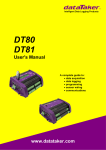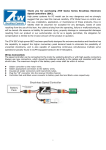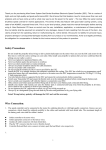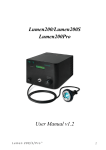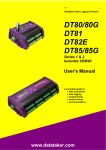Download Errata for “User`s Manual for dataTaker DT800 data logger” 19 Jan
Transcript
Errata for “User’s Manual for dataTaker DT800 data logger”
19 Jan 2006
(UM0068A2-ERA3)
This document details errors, omissions and changes to Revision A2 of the DT800 User’s Manual.
To determine the revision number of your copy, check the document code printed on the title page.
This will be of the form UM-0068-xx, where xx is the revision number.
If you have an earlier revision of the manual (A0 or A1) then we recommend that you obtain the
current revision, which is applicable to DT800s running the currently released firmware (Version
4.00 and later). Revision A2 of the User’s Manual is available (PDF format) for free download
from the dataTaker web site, or a printed copy may be ordered.
Page(s)
17
22
22
25
29
35
43
43
43
46
52
52
52
54
57
Errata Description
In the example program, the ALARM2 line should read:
ALARM2(4TT>110.0)3DSO,1CV”Over temp”{[RB5S]}
Delete the entry in the table for ‘C’ (program change) record types. These are not
included in logged data.
Delete the entry in the table for ‘B’ (burst) record types. Burst data are returned as ‘D’
records. Two new data record index entries have been defined for burst data: 6 = burst
complete, 7 = burst timeout.
PC Card slot does not support modem cards.
Currently the Attention LED only lights if SATTN or 2WARN=1 commands are
issued. The various alarm conditions listed (eg log full, internal temperature limit
exceeded) are not implemented.
Mounting hole diameter is 5.2mm
Recess around mounting hole diameter (ie. max screw head diameter) is 13.5mm
Depth of recess (ie. max screw head height) is 5.0mm
In section “Always trying to sleep” under “Sleep Conditions” the bullet point: “The
DT800’s Host RS232 port RI (Ring Indicator) line has been asserted within the last 30
seconds” is invalid. The RI signal is ignored.
In section “Low-Power Operation”: the DT800 may also be awoken if its serial sensor
port receives a character or CTS changes to active.
In the example, [LOGON] should be {[LOGON]}
In the section “Trigger on external event”, for edge triggering the minimum pulse
width is approx 16ms. This also applies to the software only counter channels C9-C16
(see page 157).
The default value of the “m” (number of background measurements) parameter for the
,FAST modifier is 10, not 2
The “ADC_frequency” parameter passed to the ,FAST modifier is actually in Hz
(unlike P60, which is in kHz) so the maximum (and default) is 100000, not 100.
The default value of the “mains frequency” parameter for the ,FAST modifier is 0, not
1000 (0 means sample at the specified clock rate without regard to mains frequency)
Valid range of “speed” parameter for burst schedule is 50 Hz to 100000 Hz
Note that the burst mode analog trigger level is approximate and may differ slightly
from the measured value on the trigger channel. For example, if you set
1VNC(LEVEL>500) then the actual trigger value (as evidenced by the captured
1VNC values) may actually be, say, 525mV instead of 500mV.
UM0068A2-ERA3
Page 1 of 5
60,61,96 “actionProcesses” in DO/IF/ALARM cannot return values for channels. For example
ALARM(1V>100){[2V]} will sample 2V whenever 1V is greater than 100mV,
however the value will not be returned. This is because the channel is sampled in the
same schedule as the alarm is defined in and as such cannot be returned conditionally
as variable length data records are not supported by the logger.
63
In the example in “Number of fundamental samples per reading”, the actual
measurement order for a V channel is Vdiff, Vdiff, Vzero+, Vzero-.
63
Note that a VNC channel type do not auto range. That is, it has a default channel
option of GL20V.
64
BGV requires 8 fundamental samples, not 4 as shown.
64
Maximum resistance value is 10M ohm, although accuracy is not guaranteed above
10k ohm.
65, 70
For RTD/thermistor channel types (R, PT385, PT392, NI, CU and YSxx) the P
channel option specifies the power excitation level in uW, not mW. The default
channel options for PT385 should therefore be listed as (100, P7000) not (100,P7), and
similarly for the other channel types.
66
The AS channel type uses 1 fundamental sample, not 4.
66
For the C channel type the page reference should be page 157, not page 154.
66, 154 Digital State Outputs: there are various inconsistencies and errors in relations to the
behaviour and nature of the outputs. The following statements clarify the situation:
• Outputs are pulled up to +3.3V (not 5V) and the value of the pull-up resistor is 47k
Ohms not 15k Ohms.
• The default state of outputs is ON (high)
• The inputs are only usable when outputs are ON (high)
• When controlling an external relay etc. the output should be configured to sink
current (as per diagram on page 184), hence to turn the relay on you need to do
1DSO=0.
69
Delete the last sentence in System Timers section, about the timer being set to 0 if set
to an out of range value.
69
10SV also returns 0 for RX schedule
70, 85
Multiple Reports: The presence of statistical options for a channel does not require the
presence of statistical options in every channel list.
71
Input termination: default is “U” for all channel types
72
The default excitation levels (ie. if just I or V or P is specified) are not shown. The
values are I = 1mA, V=5000mV, P=5000uW.
73
For the “Tn” channel option see page 91 for a description of the formula that is used
for thermistor scaling.
74
Rainflow channel option should appear below the configuration line.
80
“Alarms”, “Events”, “Ini” and “Temp” directories are not created on the memory card.
83
For U[from][to], “from” and “to” should be specified as date,time or date (not
time,date)
85
The NUM channel option appends “(Num)” to the units
87
In the table describing the function of the rainflow variables, the horizontal dividing
line should be under d-7, not above it.
91
Note that a maximum of six polynomial coefficients can be entered
98
If an alarm is true then DSO is 0 (low/active); if alarm is false then DSO is 1 (high).
96-98
digitalAction can also be a CV, eg. ALARM(..)1CV,2DS is valid. If the alarm is
TRUE then the channel variable (CV) will be set to 1 (TRUE), if the alarm is FALSE
then the CV will be set to 0 (FALSE).
UM0068A2-ERA3
Page 2 of 5
107-109
107-110
108
108
109
111
112
112
112
115
116-117
117
122
131
133
136
143
149
152
152,157
The statement that parameters P11, P31, P39, P50 and P51 are “kept during reset” is
not correct.
Parameters P11, P46, P57 and P60 are sampled and stored at the time a schedule is
defined. You should always set the value of these parameters prior to defining the
schedule.
European date format (P31=1) should be DD/MM/YYYY
P38 range is 1-255
P46 range is 1-255
/G switch is not implemented on DT800
/V switch (dump event log on error reset) is not implemented on DT800.
/X switch is not implemented on DT800.
/Y switch is not implemented on DT800.
Profile example PROFILE"HOST_PORT","MODEM_INSTALLED"="CHECK" demonstrates an
obsolete profile key. Delete this example.
Delete all references to FLASHUSERINI, DELFLASHUSERINI, FLASHONRESET,
DELFLASHONRESET. These commands are not necessary and will be deprecated in
a future release of the firmware. All changes made to the USER.INI file are always
copied directly to flash as well so there is no need to use the FLASHUSERINI
command. The DELUSERINI command will delete the copy of the USER.INI in flash
as well as the one held on the RAM disk. The RUNJOBONRESET will copy the
ONRESET.DXC job to the FLASH as well as the RAM disk. The DELJOBONRESET
will delete the ONRESET.DXC file from both FLASH and the RAM disk.
In the section “Setting the DT800’s Clock/Calendar”, the paragraph beginning “Of
course, you can use the DT800 without setting its clock/calendar…” should be
replaced with:
“Time and date are maintained when the logger is switched off or reset. If the logger is
switched off and the internal Memory-Backup battery (see page 42) is removed or
discharged, then the date\time will be reset to 1989/01/01 00:00:00.”
The lines in the sample status report should be numbered 1 to 8, not 0 to 7.
The diagram showing modem power relay driven from digital output should have the
coil connected to +12V (or an external supply) not Gd.
DeTransfer Version 3.27 and later includes an “Extra Timeout” field on the connection
dialog which removes the need to edit the registry as described here.
Update footnote: “Use the command WINIPCFG for Windows 95 and 98, the
command WNTIPCFG for windows NT, and the command IPCONFIG for DOS and
Windows 2000 or XP.
TK thermocouple composition should be 2%Mn (Manganese) not 2%min
Analog Output terminal: Ao output voltage is set using VO channel type (see p63).
Note that Ao is not available (ie. it may be set to a different voltage to that set using
VO) whilst doing an analog frequency measurement (F channel type), or a leveltriggered burst measurement.
Digital Channel Specifications:
• For D1-D6 and D7-D8 change Specification for “Low–pass filter – active drive
(for example, logic device)” from 200kHz to 20kHz.
• Add specifications for D1-D6 and D7--D8 – output rise time (approx) 5ms. Output
fall time (approx) 100us.
• Add specification for D7-D8 – Maximum output current (open drain FET) 100mA.
Counters 9-16 are sampled at a rate of 60Hz, hence the minimum input pulse width is
16ms, and hence the max count frequency for a 50% duty cycle input is 30Hz (not
UM0068A2-ERA3
Page 3 of 5
158
158
161
161
40Hz).
Add the following note regarding the CT pin of the serial sensor port:
“The CT pin of the serial sensor port is an input that will wake the logger out of sleep
mode when external power is turned to the unit. The maximum voltage that can be
applied to this input is +/-15 VDC. The Input impedance is12 K Ohm.”
Flow control is not implemented on the serial sensor port. The “flowcontrol” option
(NOFC, HWFC, SWFC) is ignored.
\e and \p are not supported as output actions. These are only supported in input strings.
The following describes the operation of the “width” and “precision” specifiers:
Minimum field width for output
An optional minimum field width, expressed as an decimal integer constant, may be
specified. The constant must be a nonempty sequence of decimal digits that do not
begin with a zero digit (which would be taken to be the 0 flag). If the converted value
(including prefix) results in fewer characters than the specified field width, then pad
characters (space or zero) are used to pad the value to the specified width. If the
converted value results in more characters than the specified field width, then the field
width is expanded to accommodate it without padding.
Precision specification for output
An optional precision specification may be used, expressed as a period followed by an
optional decimal integer. The precision specification is used to control
• the minimum number of digits to be printed for d, i, o, x, and X conversions
• the number of digits to the right of the decimal point in e, E, and f conversions
• the number of significant digits in the g and G conversions
• the maximum number of characters to be written from a string in the s conversion.
Using a CV to control width and precision
The field width (or field width and precision) may also be specified by an asterisk, *,
in which case the value of the first (or first and second) nCV argument specifies the
width/precision.
162
163
163
163
For example, the following causes the value of 2CV to be output as a floating point
value. The minimum number of characters to be output is 5 (as specified by 1CV).
1CV=5 1SERIAL(“{%*f[1CV,2CV]}”)
The descriptions of the “text”, “\nnn” and “^char” input actions are unclear. Each
character in the sequence must occur, in order, in the input data stream, but each may
be preceded by any number of other characters. For example an input action of “abc”
will match input data of “0ZCCaaaQQbJJJ42c”.
The “width” specifier indicates the maximum number of characters to be read for a
conversion. For example, if %4d is a conversion that is being processed and the input
buffer contains “102033456” then the maximum field width of 4, as specified in the
conversion, means that only “1020” from the start of the input buffer will be
converted.
The “%i” input conversion specification means interpret as hexadecimal if the number
starts with “0x” or “0X”, interpret as octal if number starts with “0”, otherwise
interpret as decimal.
Note that “%b” reads binary data (most significant byte first) without doing any input
conversion. Thus %1b is equivalent to %1c. So if the input string is “123.456”:
UM0068A2-ERA3
Page 4 of 5
•
•
•
163
163
164
174
176
181
189
189
%b would set nCV to 49 (ASCII “1”), leaving “23.456” in the receive buffer
%2b would set nCV to 12594 (49*256 + 50), leaving “3.456” in the receive buffer
%3b would set nCV to 3223859 (49*65536 + 50*256 + 51), leaving “.456” in the
receive buffer
Note that due to the limited precision of CVs, the maximum practical width value is 3
(24 bits).
In the example under [abc]: If the control string is %[pq3rs][1$] and the received
string is “pp3rpsab3pr” then “pp3rps” will be placed into 1$, leaving “ab3pr” in the
input buffer.
The scanset negation character is “~” not “^”.
Note that the “username~units” and “=nCV” channel options (see page 75) are also
valid for the serial channel.
In the table under figure 117, replace “3*BGV(6W)” with “4BGV(6W)” and replace
“11*BGV(6W)” with “12BGV(6W)”.
The statement about the bridge voltage being calculated from measured current applies
to BGI not BGV
1LM35 will perform a 4-wire measurement. For the 3-wire connection shown, the
command would be 1+LM35, not 1LM35.
In the example where six LM35s are connected to a channel pair, the command to read
sensor E should be 2+LM35, not 2*LM35
ASCII-Decimal Table, Decimal 3 in ASCII is ETX not EXT.
Delete entry for ASCII 98, add ^b in control column for ASCII 34 (")
UM0068A2-ERA3
Page 5 of 5







